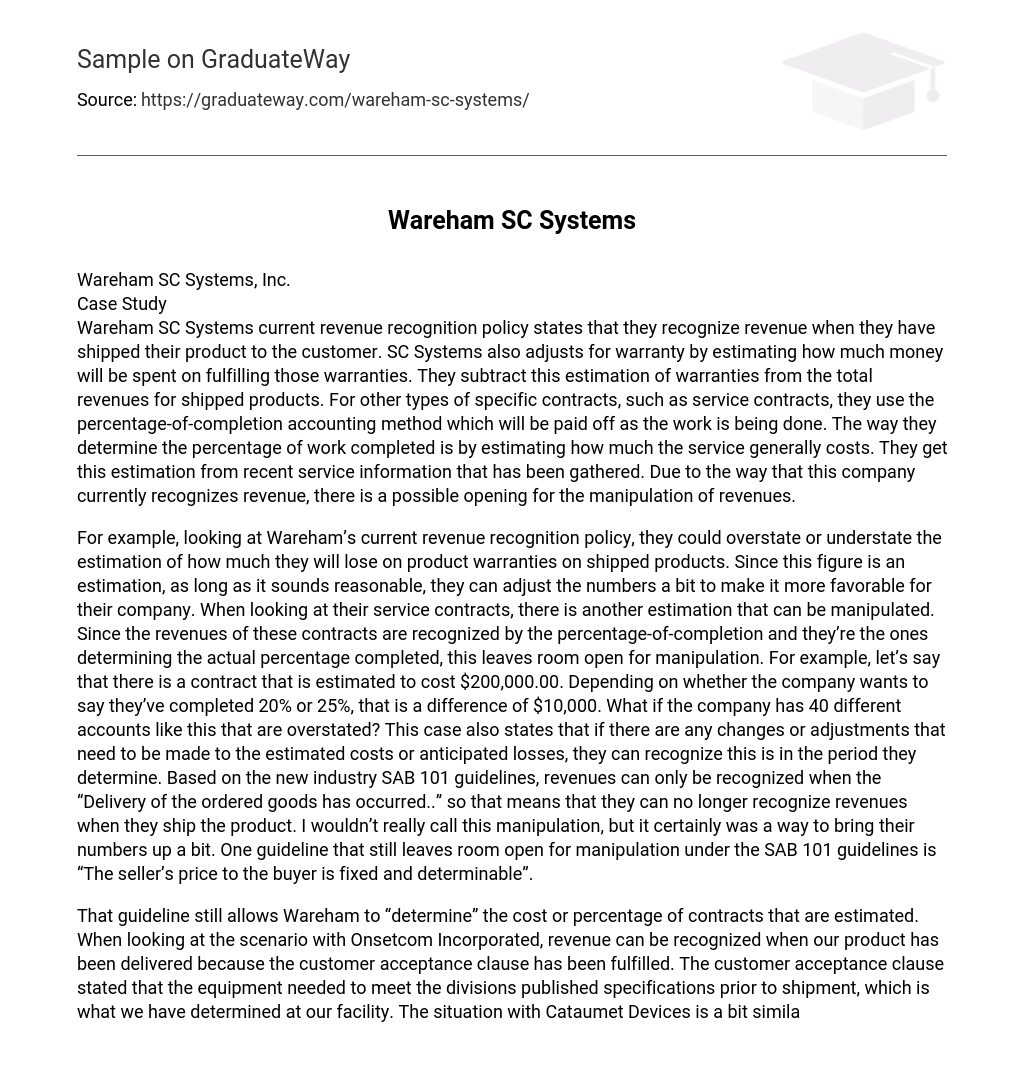Wareham SC Systems current revenue recognition policy states that they recognize revenue when they have shipped their product to the customer. SC Systems also adjusts for warranty by estimating how much money will be spent on fulfilling those warranties. They subtract this estimation of warranties from the total revenues for shipping products. For other types of specific contracts, such as service contracts, they use the percentage-of-completion accounting method which will be paid off as the work is being done. The way they determine the percentage of work completed is by estimating how much the service generally costs. They get this estimation from recent service information that has been gathered. Due to the way that this company currently recognizes revenue, there is a possible opening for the manipulation of revenues.
For example, looking at Wareham’s current revenue recognition policy, they could overstate or understate the estimation of how much they will lose on product warranties on shipping products. Since this figure is an estimation, as long as it sounds reasonable, they can adjust the numbers a bit to make it more favorable for their company. When looking at their service contracts, there is another estimation that can be manipulated. Since the revenues of these contracts are recognized by the percentage-of-completion and they’re the ones determining the actual percentage completed, this leaves room open for manipulation.
For example, let’s say that there is a contract that is estimated to cost $200,000.00. Depending on whether the company wants to say they’ve completed 20% or 25%, that is a difference of $10,000. What if the company has 40 different accounts like this that are overstated? This case also states that if there are any changes or adjustments that need to be made to the estimated costs or anticipated losses, they can recognize this is in the period they determine. Based on the new industry SAB 101 guidelines, revenues can only be recognized when the “Delivery of the ordered goods has occurred..” so that means that they can no longer recognize revenues when they ship the product. I wouldn’t really call this manipulation, but it certainly was a way to bring their numbers up a bit. One guideline that still leaves room open for manipulation under the SAB 101 guidelines is “The seller’s price to the buyer is fixed and determinable”.
That guideline still allows Wareham to “determine” the cost or percentage of contracts that are estimated. When looking at the scenario with Onsetcom Incorporated, revenue can be recognized when our product has been delivered because the customer acceptance clause has been fulfilled. The customer acceptance clause stated that the equipment needed to meet the divisions published specifications prior to shipment, which is what we have determined at our facility. The situation with Cataumet Devices is a bit similar due to the fact that half of the sales agreement has been achieved. The Glendale division has provided a product that meets all of the standard published performance specifications, but the customer could still reject this if it “could not be satisfactorily integrated into the new line.” Since the sales agreement hasn’t been fully achieved, we cannot recognize revenue until they have been able to satisfactorily integrate the product into their new assembly line.
For Sandham Inc., since there is a customer-acceptance provision, the Advanced Technology Division cannot recognize revenue until the installed equipment has met all specified criteria. Once accepted, our division is due 80% of the revenues from the day it was delivered. However, if 45 days have passed without acceptance for example, we cannot recognize the 80% of revenues because there is still a possibility that they can return our product and receive their money back. Once the customer accepts our product, we are due the remaining 20% 30 days after the acceptance has occurred. Now looking at XL Semi, customer acceptance takes place at the division’s facility prior to shipment.
Based on this fact, we can recognize 90% of the total arrangement upon delivery. The final 10% cannot be recognized until final acceptance has occurred. This will take place once the product has been completely installed. As far as the cost of installation services goes, we cannot recognize this cost until the price has been determined. Right now it is an approximation of 1% to 3%. The Technical Devices Division has decided to change its sales strategy. Based on this new strategy, Distributors must now pay 8% per month for 5 periods equaling 40%, and then they must pay the final 60% six months after the delivery occurred. Since this can be seen as a consignment due to the fact that we allow for return of excess inventories, the distributors have a right to return what they haven’t sold in that period.
The Technical Devices Division cannot recognize the 8% per month unless the distributor has sold at least 8% of the inventory in that month. Whatever wasn’t sold can be returned, and the Technical Devices Division can only recognize the amount that was sold in that particular month. The final industry, Ashaban Industries are a risky customer, but since we have delivered the goods and they have accepted the 2 million dollar accounts, we can go ahead and recognized the revenue upon payment of goods. Our division can only recognize the payments they receive as revenue. All other payments that are outstanding cannot be recognized yet.





